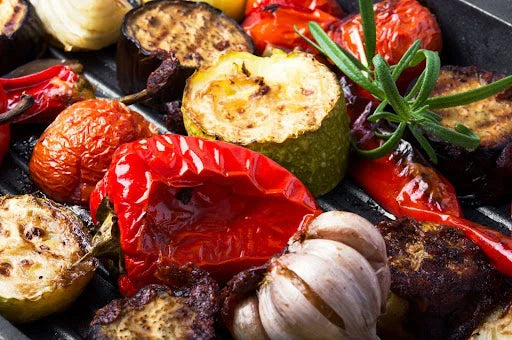
How Long to Cook Vegetables for Soup? Simple Tips for Beginners and Pros
Teilen
Making the perfect soup starts with understanding one fundamental principle: timing is everything. When you know precisely how long to cook vegetables for soup, the difference between a mediocre meal and a restaurant-quality dish becomes crystal clear. Each vegetable has its own cooking personality, requiring specific attention to achieve that ideal balance of tenderness and flavor retention.
The art of soup-making transforms simple ingredients into comfort food that warms both body and soul. However, many home cooks struggle with overcooked, mushy vegetables or undercooked, tough pieces that ruin an otherwise perfect bowl. This comprehensive guide will teach you the exact timing needed for each type of vegetable, ensuring your soups achieve professional-level results every single time.

Whether you're a kitchen newcomer or an experienced cook looking to refine your technique, mastering vegetable cooking times will elevate your soup game significantly. The key lies in understanding that different vegetables require different approaches, and knowing when to add each ingredient creates layers of flavor and texture that make soups truly memorable.
Why Cooking Time Matters for Soup Vegetables
Understanding the science behind cooking vegetables transforms your approach to soup-making entirely. When heat penetrates vegetable cell walls, it breaks down pectin and cellulose, softening the structure while releasing natural sugars and flavors. This process must be carefully controlled to achieve optimal results.
The Science Behind Cooking Vegetables
Cell structure varies dramatically between different types of vegetables. Dense root vegetables like carrots and potatoes contain more cellulose and require longer cooking times to become tender. Meanwhile, delicate leafy greens have thinner cell walls that break down quickly, making them prone to overcooking if added too early.
Temperature control plays a crucial role in this process. Gentle simmering allows vegetables to cook evenly throughout, while rapid boiling can cause exteriors to become mushy before interiors reach the desired tenderness. Understanding this principle helps you choose the right heat level for different cooking stages.
Texture and Consistency Goals
Perfect soup vegetables maintain their structural integrity while becoming fork-tender. This balance requires precise timing and attention to how each vegetable responds to heat. Root vegetables should yield easily to gentle pressure but retain their shape, while softer vegetables should maintain some bite without becoming stringy or tough.
The final texture depends heavily on your soup style. Chunky vegetable soups require firmer vegetables that hold their shape, while pureed soups benefit from completely tender vegetables that blend smoothly. Adjusting your cooking approach based on the intended final result ensures consistent success.
Flavor Development Through Proper Timing
Cooking time directly impacts flavor concentration and development. Vegetables cooked too briefly may taste raw or bland, while overcooked vegetables lose their natural sweetness and develop bitter undertones. The sweet spot maximizes natural flavors while creating the perfect textural foundation for your soup.
How Long to Cook Common Vegetables for Soup

Mastering the timing for different vegetable categories simplifies the entire soup-making process. Each group requires specific attention, and understanding these patterns helps you plan cooking sequences effectively.
Root Vegetables: The Foundation
Root vegetables form the backbone of most hearty soups and require the longest cooking times. These dense vegetables need adequate time to soften completely while developing their natural sweetness.
Cooking times for root vegetables:
- Potatoes (cubed): 15-20 minutes
- Carrots (sliced): 12-15 minutes
- Turnips and parsnips: 15-18 minutes
- Sweet potatoes: 12-15 minutes
- Onions: 8-12 minutes
Start these vegetables first, as they need the most time to reach optimal tenderness. Cut them into uniform pieces to ensure even cooking throughout.
Leafy Greens and Soft Vegetables
Delicate vegetables require minimal cooking time to maintain their color, nutrition, and texture. These ingredients should be added near the end of the cooking process.
Quick-cooking vegetable timing:
- Spinach: 2-3 minutes
- Kale (chopped): 5-7 minutes
- Zucchini: 5-8 minutes
- Bell peppers: 6-8 minutes
- Tomatoes: 3-5 minutes
Adding these vegetables too early results in mushy, overcooked textures that detract from the soup's overall appeal.
Cruciferous Vegetables
These nutritious vegetables fall somewhere between root vegetables and leafy greens in terms of cooking requirements. They need enough time to become tender while retaining their distinctive flavors.
Medium-cooking vegetable times:
- Broccoli florets: 6-8 minutes
- Cauliflower: 8-10 minutes
- Brussels sprouts (halved): 8-12 minutes
- Cabbage (chopped): 10-12 minutes
These vegetables benefit from being added during the middle stages of cooking, after root vegetables have begun softening but before quick-cooking ingredients join the pot.
Tips for Perfect Soup Every Time
Achieving consistent results requires attention to preparation details and cooking techniques that professional chefs use in commercial kitchens.
Preparation Techniques That Make a Difference
Uniform cutting ensures even cooking across all vegetable pieces. When determining how long to cook vegetables for soup, consistent sizing becomes crucial for timing accuracy. Aim for pieces between half-inch and one-inch, depending on your soup style preferences.
Sharp knives make cleaner cuts that help vegetables maintain their integrity during cooking. Clean cuts heal faster and retain more moisture, preventing vegetables from becoming dry or tough during the cooking process.
Strategic Addition Timing
Recommended vegetable addition sequence:
- Aromatics (onions, garlic, celery): Start first
- Root vegetables: Add after aromatics soften
- Medium-density vegetables: Add midway through cooking
- Quick-cooking vegetables: Add during the final minutes
- Leafy greens: Add just before serving
This systematic approach ensures each ingredient reaches its optimal texture simultaneously, creating perfectly balanced results every time.
Temperature and Heat Management
Maintain a gentle simmer rather than a rolling boil for most soup cooking. High heat can cause vegetables to break apart on the outside while remaining undercooked inside. Low, steady heat penetrates evenly, creating uniform texture throughout each piece.
Use a timer to track cooking stages, especially when learning proper timing for different vegetables for soup combinations. Consistent timing builds muscle memory and helps develop intuitive cooking skills over time.
Adjusting Cooking Times Based on Cooking Method
Different cooking methods require timing adjustments to achieve similar results. Understanding these variations helps you adapt recipes to available equipment and time constraints.
Stovetop Cooking Techniques
Traditional stovetop cooking offers the most control over temperature and timing. This method works best for beginners learning to gauge doneness by sight and texture. Monitor vegetables closely during cooking, adjusting heat as needed to maintain a steady simmer.
The open pot allows for easy stirring and tasting throughout the process. Add vegetables in stages, tasting periodically to check doneness levels. This hands-on approach builds confidence and cooking intuition.
Slow Cooker Adaptations
Slow cookers require different timing approaches since heat levels remain constant throughout cooking. Dense vegetables still need longer cooking times, but the overall process extends significantly compared to stovetop methods.
Slow cooker timing adjustments:
- Root vegetables: Add at the beginning, cook 6-8 hours on low
- Medium vegetables: Add during the final 2-3 hours
- Quick-cooking vegetables: Add during the final 30-60 minutes
The gentle, consistent heat of slow cookers helps vegetables retain more nutrients while developing deep, complex flavors over extended cooking periods.
Pressure Cooker Efficiency

Pressure cooking dramatically reduces cooking times while maintaining excellent texture and flavor development. This method works particularly well for tough root vegetables that normally require extended cooking periods.
Pressure cooker timing guide:
- Root vegetables: 4-6 minutes under pressure
- Medium vegetables: 2-3 minutes under pressure
- Quick vegetables: Add after pressure cooking completes
Use natural pressure release for dense vegetables and quick release for softer varieties to prevent overcooking during the cooling process.
Professional Tips for Advanced Results
Understanding when vegetables reach optimal doneness requires developing sensory skills that go beyond simple timing. Visual cues, texture tests, and aroma changes all indicate readiness levels.
Test doneness by piercing vegetables with a fork or knife tip. Properly cooked vegetables should offer slight resistance without being stiff or mushy. This sweet spot maximizes both flavor and nutritional value.
Color changes also indicate cooking progress. Most vegetables become more vibrant initially, then begin dulling as cooking continues. Stop cooking when colors remain bright and appealing rather than waiting for significant color loss.
Taste testing throughout the cooking process helps calibrate timing for personal preferences. Some people prefer slightly firmer textures, while others enjoy completely tender vegetables. Adjust timing based on household preferences and soup style goals.
Conclusion
Mastering how long to cook vegetables for soup transforms ordinary ingredients into extraordinary meals that satisfy both novice and experienced palates. The key lies in understanding each vegetable's unique characteristics and timing requirements, then applying systematic cooking techniques that ensure consistent results.
Experiment with different combinations of vegetables for soup to discover new favorite flavor profiles. With practice, determining optimal cooking times becomes instinctive, allowing you to create memorable soups that bring people together around the table.

